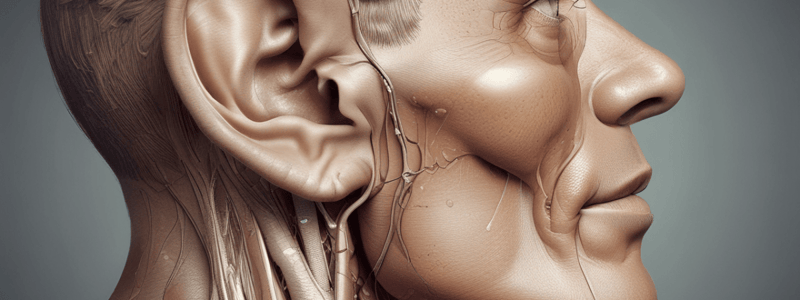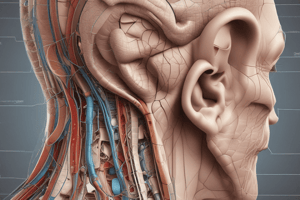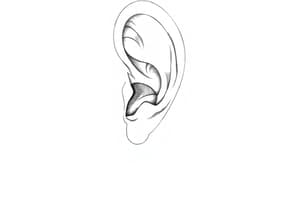Podcast
Questions and Answers
What is the primary function of the vestibulocochlear nerve?
What is the primary function of the vestibulocochlear nerve?
- To detect movements and pressure changes within the surrounding water
- To capture odor particles from the air
- To transmit visual stimuli
- To transmit nerve impulses to the central nervous system (correct)
What is the name of the organ responsible for both hearing and equilibrium?
What is the name of the organ responsible for both hearing and equilibrium?
- Outer ear
- Middle ear
- Inner ear (correct)
- Vestibular system
What is the function of the macula utriculi, macula saccule, and crista ampullaris?
What is the function of the macula utriculi, macula saccule, and crista ampullaris?
- To transmit nerve impulses to the central nervous system
- To transduce auditory stimuli to mechanical stimuli
- To detect angular acceleration and deceleration (correct)
- To collect auditory stimuli
What is the name of the nerve that enters the ear together with the vestibulocochlear nerve?
What is the name of the nerve that enters the ear together with the vestibulocochlear nerve?
What is the name of the system that detects movements and pressure changes within the surrounding water in fish and aquatic amphibians?
What is the name of the system that detects movements and pressure changes within the surrounding water in fish and aquatic amphibians?
What is the name of the organ found in snakes that is utilized for tongue extension and tongue retraction?
What is the name of the organ found in snakes that is utilized for tongue extension and tongue retraction?
What is the shape of the manubrium of the malleus in the dog?
What is the shape of the manubrium of the malleus in the dog?
What is the shape of the tympanic membrane in the horse?
What is the shape of the tympanic membrane in the horse?
Which of the following structures is responsible for the deviation of the basilar membrane in the cochlea?
Which of the following structures is responsible for the deviation of the basilar membrane in the cochlea?
What is the type of gland found in the external acoustical meatus?
What is the type of gland found in the external acoustical meatus?
What is the name of the ventral expansion of the auditory tube in horses?
What is the name of the ventral expansion of the auditory tube in horses?
What is the function of the auditory ossicles?
What is the function of the auditory ossicles?
What is the name of the structure that leads to the deflection of the apical hair cell stereocilia?
What is the name of the structure that leads to the deflection of the apical hair cell stereocilia?
What is the type of tissue that attaches the annular cartilage to the osseous rim of the external acoustic meatus?
What is the type of tissue that attaches the annular cartilage to the osseous rim of the external acoustic meatus?
What is the name of the tube that connects the middle ear to the pharynx?
What is the name of the tube that connects the middle ear to the pharynx?
What is the primary function of the endolymphatic system in amphibians and reptiles?
What is the primary function of the endolymphatic system in amphibians and reptiles?
Which of the following structures is derived from the neuroectoderm?
Which of the following structures is derived from the neuroectoderm?
What is the primary function of the otoliths in the vestibular apparatus?
What is the primary function of the otoliths in the vestibular apparatus?
What is the composition of the cupula in the crista ampullaris?
What is the composition of the cupula in the crista ampullaris?
What is the location of the crista ampullaris in the semicircular duct?
What is the location of the crista ampullaris in the semicircular duct?
Match the number to the part of the ear, based off of the image.
Match the number to the part of the ear, based off of the image.
Match the number to the part of the ear, based on the image.
Match the number to the part of the ear, based on the image.
What is number 1 referring to?
What is number 1 referring to?
What is number 2 referring to?
What is number 2 referring to?
What is number 3 referring to?
What is number 3 referring to?
What is number 4 referring to?
What is number 4 referring to?
What is number 8 referring to?
What is number 8 referring to?
What is number 9 referring to?
What is number 9 referring to?
What is number 1 referring to?
What is number 1 referring to?
What is number 3 referring to?
What is number 3 referring to?
What is number 8 referring to?
What is number 8 referring to?
What is number 9 referring to?
What is number 9 referring to?
What is number 10 referring to?
What is number 10 referring to?
Match the number to the correct term, in regards to the Tympanic Cavity.
Match the number to the correct term, in regards to the Tympanic Cavity.
What is this image depicting?
What is this image depicting?
Match the number to the correct term, in regards to the Tympanic Membrane.
Match the number to the correct term, in regards to the Tympanic Membrane.
Match the number to the correct term, in regards to the Guttural Pouch.
Match the number to the correct term, in regards to the Guttural Pouch.
Match the number to the correct term, in regards to the Vestibular Apparatus.
Match the number to the correct term, in regards to the Vestibular Apparatus.
Match the number to the correct term, in regards to the vestibular apparatus.
Match the number to the correct term, in regards to the vestibular apparatus.
Match the number to the correct term, in regards to the vestibular apparatus.
Match the number to the correct term, in regards to the vestibular apparatus.
Match the number to the correct term, in regards to the Cochlea.
Match the number to the correct term, in regards to the Cochlea.
Match the number to the correct term, in regards to the Lateral Line Organ.
Match the number to the correct term, in regards to the Lateral Line Organ.
What is number 5 referring to?
What is number 5 referring to?
Flashcards are hidden until you start studying
Study Notes
Ear: General Info
- The ear has three main functions: collecting auditory stimuli, transducing auditory stimuli to mechanical and nerve stimuli, and transmitting nerve impulses to the central nervous system (CNS) via the vestibulocochlear nerve (cranial nerve 3)
- The ear is responsible for hearing and balance, with the inner ear being the organ for both hearing and equilibrium, and the external and middle ear representing a sound collecting and conducting apparatus
Organs of Equilibrium and Motion Detection
- Organs of equilibrium and motion detection include the utricle, saccule, and semicircular ducts
- Within these structures are specialized neuroepithelial cells: macula utriculi, macula saccule, and crista ampullaris (sensitive to angular acceleration/deceleration)
Lateral Line System and Chemoreception
- The lateral line system in fish, larval, and adult aquatic amphibians uses tactile sense organs to detect movements and pressure changes within the surrounding water
- Jacobson's (vomeronasal) organ is an example of a chemoreception mechanism in snakes, utilized for tongue extension and retraction to capture and detect odor particles
Cochlea
- The cochlea is a spiral structure divided into three chambers and is the organ of hearing
- The organ of Corti is the spiral organ within the cochlea
- Fluid waves traveling in the Scala vestibuli result in deviation of the basilar membrane, leading to deflection of the apical hair cell stereocilia
Parts of the Ear
- The ear can be divided into the external ear, middle ear, and inner ear
- The external ear contains the auricle or pinna and the external auditory meatus
- The external acoustic meatus contains ceruminous glands, which secrete cerumen (ear wax)
- The middle ear contains the tympanic cavity, tympanic membrane (ear drum), and 3 auditory ossicles and their associated ligaments and muscles
- The inner ear is composed of a membranous labyrinth enclosed in the temporal bone
Endolymph
- Endolymph is a fluid within the membranous labyrinth of the inner ear that is high in potassium
- It bathes inner ear cells, allowing them to function normally
- The endolymphatic system results in sac-like structures behind the eyes of amphibians and reptiles, which function in controlling pressure, fluid, and ion (especially calcium) homeostasis
Vestibular Apparatus
- The vestibular apparatus detects static equilibrium and linear acceleration, as well as rotational movement
- Within the utricle and saccule, maculae run perpendicular to one another
- Otoliths are located within a gelatinous membrane and their movements bend the stereocilia of neurosensory hair cells
- The cupula is gelatinous and detects movement by the stereocilia of neurosensory hair cells
Studying That Suits You
Use AI to generate personalized quizzes and flashcards to suit your learning preferences.





